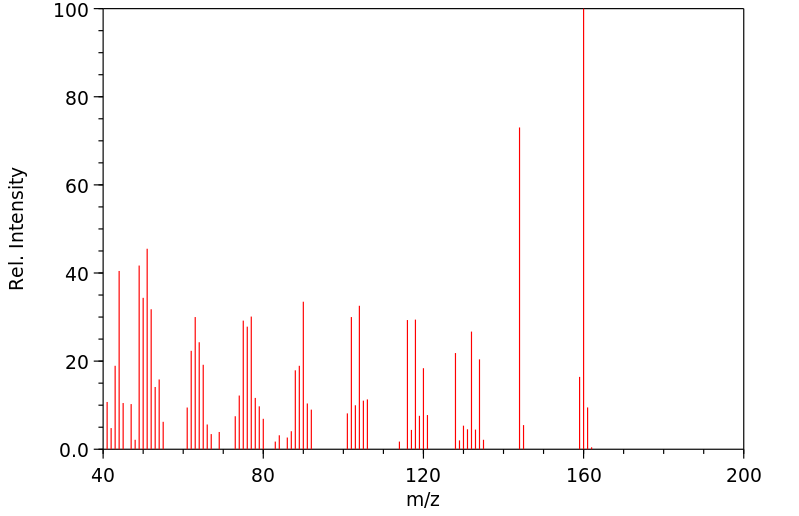1,4-苯二甲腈N,N-二氧化物 | 3729-34-8
中文名称
1,4-苯二甲腈N,N-二氧化物
中文别名
——
英文名称
Terephthalonitril-dioxid
英文别名
Terephthalonitril-di-N-oxid;Terephthalonitrile N,N'-dioxide
CAS
3729-34-8
化学式
C8H4N2O2
mdl
MFCD00077973
分子量
160.132
InChiKey
JRVRIUGIFUNROE-UHFFFAOYSA-N
BEILSTEIN
——
EINECS
——
-
物化性质
-
计算性质
-
ADMET
-
安全信息
-
SDS
-
制备方法与用途
-
上下游信息
-
文献信息
-
表征谱图
-
同类化合物
-
相关功能分类
-
相关结构分类
计算性质
-
辛醇/水分配系数(LogP):-1.99
-
重原子数:12
-
可旋转键数:0
-
环数:1.0
-
sp3杂化的碳原子比例:0.0
-
拓扑面积:53.5
-
氢给体数:0
-
氢受体数:3
SDS
反应信息
-
作为反应物:描述:参考文献:名称:Reaction of perfluorinated nitriles with benz-and terephthalamidoximes for the isolation of mixed 1,2,4-oxadiazoles摘要:The reaction of perfluorinated nitriles with benz- and terephthalamidoximes afforded amidoximimidates which can form mixed 1,2,4-oxadiazoles in high yield under mild conditions by the action of acid fluorides of perfluorocarboxylic acids. The structure of the compounds obtained was confirmed by the methods of C-13, F-19, and H-1 NMR, and by IR spectroscopy.DOI:10.1007/bf00864345
-
作为产物:描述:参考文献:名称:通过单击聚合一锅合成精确的聚异恶唑:铜(I)催化的炔烃与腈类化合物的1,3-偶极环加成反应摘要:本文报告了一种用于制备聚合物的单罐新方法,该方法涉及双击化学反应。在一个锅中,通过逐步添加反应物,依次发生两次点击反应。第一次点击反应是生产用于第二次点击反应的单体以进行聚合。所述点击聚合不同于通常的点击聚合,其中重氮化物与二炔反应。一氧化氮,原位产生通过首先形成醛糖肟而不是叠氮化物的点击反应,避免了叠氮化物的毒性和爆炸性,并且更加安全,易于操作。通过我们的一锅法,铜(I)催化炔烃与腈类化合物的1,3-偶极环加成反应生成了3,5-二取代聚异恶唑。所得的聚异恶唑与1 H NMR和IR分析获得的结构分配非常吻合,分子量高,分子量分布窄(M w / M n<1.2)和较高的区域规则性。发现这些聚合物的不良溶解性是由它们的结晶引起的。通过改变炔烃单体的结构可以提高溶解度。所有的聚合物都是热稳定的,加热到约350°C时几乎没有重量损失。©2013 Wiley Periodicals,Inc. J PolymDOI:10.1002/pola.26537
文献信息
-
Multifaceted Strategy for the Synthesis of Diverse 2,2'-Bithiophene Derivatives作者:Stanisław Krompiec、Michał Filapek、Iwona Grudzka-Flak、Aneta Slodek、Sławomir Kula、Jan Malecki、Joanna Malarz、Grażyna Szafraniec-Gorol、Mateusz Penkala、Ewa Schab-Balcerzak、Marian Paluch、Michał Mierzwa、Marek Matussek、Agata Szlapa、Michał Pajak、Dariusz Blach、Beata Marcol、Witold Danikiewicz、Bartosz Boharewicz、Agnieszka IwanDOI:10.3390/molecules20034565日期:——New catalytically or high pressure activated reactions and routes, including coupling, double bond migration in allylic systems, and various types of cycloaddition and dihydroamination have been used for the synthesis of novel bithiophene derivatives. Thanks to the abovementioned reactions and routes combined with non-catalytic ones, new acetylene, butadiyne, isoxazole, 1,2,3-triazole, pyrrole, benzene
-
Synthesis of 3,5-Disubstituted Isoxazoles through a 1,3-Dipolar Cycloaddition Reaction between Alkynes and Nitrile Oxides Generated from <i>O</i> -Silylated Hydroxamic Acids作者:Laure-Elie Carloni、Stefan Mohnani、Davide BonifaziDOI:10.1002/ejoc.201901045日期:2019.11.30by 1,3‐dipolar cycloaddition between alkynyl dipolarophiles and nitrile oxide dipoles generated in‐situ from O‐silylated hydroxamic acids in the presence of trifluoromethanesulfonic anhydride and NEt3. Thanks to the mild, metal‐free and oxidant‐free conditions that this strategy offers, the reaction was successfully applied to a wide variety of alkynyl dipolarophiles, demonstrating the tolerance of this
-
Polymerizations by 1,3-Dipolar Cycloaddition Reactions. V. The 1,3-Dipolar Polycycloadditions of Dinitrile<i>N</i>-Oxides with Diolefins作者:Yoshio Iwakura、Shinsaku Shiraishi、Masayasu Akiyama、Masahiro YuyamaDOI:10.1246/bcsj.41.1648日期:1968.7Terephthalonitrile di-N-oxide and isophthalonitrile di-N-oxide were synthesized from the corresponding hydroxamic chlorides by dehydrochlorination with triethylamine. Their chemical properties and the polycycloadditions with diolefins were examined. The polymers obtained were amorphous and their molecular weights were not so high. The thermal gravimetric analyses of them showed that the polymers were stable up to 300–350°C in air.
-
一类甲氧苯磺酰肼类GPR119激动剂、制备方法 及其用途申请人:佛山市赛维斯医药科技有限公司公开号:CN104649944B公开(公告)日:2016-08-31本发明涉及与2型糖尿病相关的药物领域。具体而言,本发明涉及一类甲氧苯磺酰肼结构的GPR119激动剂、其制备方法、以及在制备2型糖尿病药物中的应用。
-
Isoimide containing oligomers申请人:Hughes Aircraft Company公开号:EP0071372A1公开(公告)日:1983-02-09A class of relatively low molecular-weight oligomers containing at least one isoimide group and terminal groups capable of undergoing an addition polymerization reaction. The oligomers of the present invention are characterized by excellent solubility in common solvents and a melting temperature considerably lower than their cure temperature, thus enabling the oligomers to be formed into cured polymers more slowly and at lower temperatures, all without the evolution of deleterious gases.一类相对低分子量的低聚物,含有至少一个异亚胺基团和能够发生加成聚合反应的末端基团。 本发明低聚物的特点是在普通溶剂中具有极佳的溶解性,熔化温度大大低于其固化温度,从而使低聚物能够在更低的温度下更慢地形成固化聚合物,且不会产生有害气体。
表征谱图
-
氢谱1HNMR
-
质谱MS
-
碳谱13CNMR
-
红外IR
-
拉曼Raman
-
峰位数据
-
峰位匹配
-
表征信息
同类化合物
(βS)-β-氨基-4-(4-羟基苯氧基)-3,5-二碘苯甲丙醇
(S,S)-邻甲苯基-DIPAMP
(S)-(-)-7'-〔4(S)-(苄基)恶唑-2-基]-7-二(3,5-二-叔丁基苯基)膦基-2,2',3,3'-四氢-1,1-螺二氢茚
(S)-盐酸沙丁胺醇
(S)-3-(叔丁基)-4-(2,6-二甲氧基苯基)-2,3-二氢苯并[d][1,3]氧磷杂环戊二烯
(S)-2,2'-双[双(3,5-三氟甲基苯基)膦基]-4,4',6,6'-四甲氧基联苯
(S)-1-[3,5-双(三氟甲基)苯基]-3-[1-(二甲基氨基)-3-甲基丁烷-2-基]硫脲
(R)富马酸托特罗定
(R)-(-)-盐酸尼古地平
(R)-(-)-4,12-双(二苯基膦基)[2.2]对环芳烷(1,5环辛二烯)铑(I)四氟硼酸盐
(R)-(+)-7-双(3,5-二叔丁基苯基)膦基7''-[((6-甲基吡啶-2-基甲基)氨基]-2,2'',3,3''-四氢-1,1''-螺双茚满
(R)-(+)-7-双(3,5-二叔丁基苯基)膦基7''-[(4-叔丁基吡啶-2-基甲基)氨基]-2,2'',3,3''-四氢-1,1''-螺双茚满
(R)-(+)-7-双(3,5-二叔丁基苯基)膦基7''-[(3-甲基吡啶-2-基甲基)氨基]-2,2'',3,3''-四氢-1,1''-螺双茚满
(R)-(+)-4,7-双(3,5-二-叔丁基苯基)膦基-7“-[(吡啶-2-基甲基)氨基]-2,2”,3,3'-四氢1,1'-螺二茚满
(R)-3-(叔丁基)-4-(2,6-二苯氧基苯基)-2,3-二氢苯并[d][1,3]氧杂磷杂环戊烯
(R)-2-[((二苯基膦基)甲基]吡咯烷
(R)-1-[3,5-双(三氟甲基)苯基]-3-[1-(二甲基氨基)-3-甲基丁烷-2-基]硫脲
(N-(4-甲氧基苯基)-N-甲基-3-(1-哌啶基)丙-2-烯酰胺)
(5-溴-2-羟基苯基)-4-氯苯甲酮
(5-溴-2-氯苯基)(4-羟基苯基)甲酮
(5-氧代-3-苯基-2,5-二氢-1,2,3,4-oxatriazol-3-鎓)
(4S,5R)-4-甲基-5-苯基-1,2,3-氧代噻唑烷-2,2-二氧化物-3-羧酸叔丁酯
(4S,4''S)-2,2''-亚环戊基双[4,5-二氢-4-(苯甲基)恶唑]
(4-溴苯基)-[2-氟-4-[6-[甲基(丙-2-烯基)氨基]己氧基]苯基]甲酮
(4-丁氧基苯甲基)三苯基溴化磷
(3aR,8aR)-(-)-4,4,8,8-四(3,5-二甲基苯基)四氢-2,2-二甲基-6-苯基-1,3-二氧戊环[4,5-e]二恶唑磷
(3aR,6aS)-5-氧代六氢环戊基[c]吡咯-2(1H)-羧酸酯
(2Z)-3-[[(4-氯苯基)氨基]-2-氰基丙烯酸乙酯
(2S,3S,5S)-5-(叔丁氧基甲酰氨基)-2-(N-5-噻唑基-甲氧羰基)氨基-1,6-二苯基-3-羟基己烷
(2S,2''S,3S,3''S)-3,3''-二叔丁基-4,4''-双(2,6-二甲氧基苯基)-2,2'',3,3''-四氢-2,2''-联苯并[d][1,3]氧杂磷杂戊环
(2S)-(-)-2-{[[[[3,5-双(氟代甲基)苯基]氨基]硫代甲基]氨基}-N-(二苯基甲基)-N,3,3-三甲基丁酰胺
(2S)-2-[[[[[((1S,2S)-2-氨基环己基]氨基]硫代甲基]氨基]-N-(二苯甲基)-N,3,3-三甲基丁酰胺
(2S)-2-[[[[[[((1R,2R)-2-氨基环己基]氨基]硫代甲基]氨基]-N-(二苯甲基)-N,3,3-三甲基丁酰胺
(2-硝基苯基)磷酸三酰胺
(2,6-二氯苯基)乙酰氯
(2,3-二甲氧基-5-甲基苯基)硼酸
(1S,2S,3S,5S)-5-叠氮基-3-(苯基甲氧基)-2-[(苯基甲氧基)甲基]环戊醇
(1S,2S,3R,5R)-2-(苄氧基)甲基-6-氧杂双环[3.1.0]己-3-醇
(1-(4-氟苯基)环丙基)甲胺盐酸盐
(1-(3-溴苯基)环丁基)甲胺盐酸盐
(1-(2-氯苯基)环丁基)甲胺盐酸盐
(1-(2-氟苯基)环丙基)甲胺盐酸盐
(1-(2,6-二氟苯基)环丙基)甲胺盐酸盐
(-)-去甲基西布曲明
龙蒿油
龙胆酸钠
龙胆酸叔丁酯
龙胆酸
龙胆紫-d6
龙胆紫







